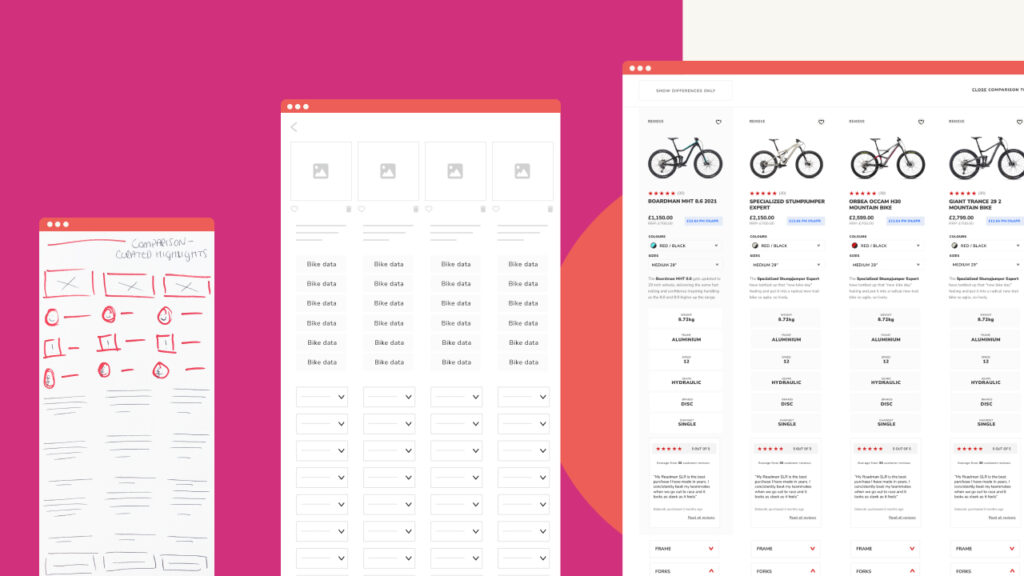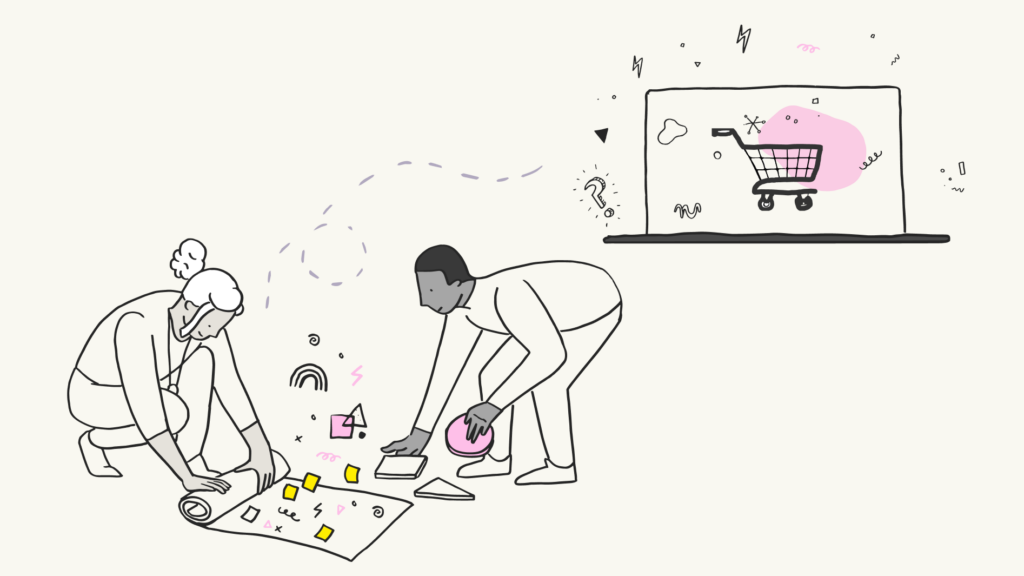Background
Digital professionals often wear several hats. I’ve been called a few things in my time. Data Analyst. Business Analyst. User Research. UX Designer. UX Consultant. T-Shaped. Out of all of them, it’s that final one that has always made me think the most. I love what being ‘T-shaped’ stands for. Being multi-skilled. Being collaborative. Having the ability to do several roles to deliver a service that wows users and clients. That was something to strive for. But is there something beyond being T-shaped? Why can’t we have several disciplines where we are highly skilled? Why must a practitioner focus on one specialism?
Let’s explore what being T-shaped means, what it can feel like, how it can add value and some drawbacks. Find out how you can become more T-shaped.
Let’s begin with the basics. And a crash course in ‘T-shaped’. The term originates from the late 80s to the early 90s and was linked to the recruitment of consultants. The concept of hiring people who had a breadth of skills, rather than just one specialism. However more recently T-shaped have come to mean something a little different, having come to the fore with the rise of agile software development. So, what does it mean?
“The vertical bar on the letter T represents the depth of your skills and expertise in a single field, whereas the horizontal bar is your breadth or ability to collaborate across disciplines with experts in other areas and apply knowledge to areas beyond your primary field.” (Forbes)

In the simplest form, we’re talking about a person with a ‘single field’ that they are particularly strong in, but who can also work well with those who specialize in other areas. As UX professionals that should sound like any member of a delivery team that you might have ever collaborated with, right? Any member of a project team should have expertise in a single field but be able to collaborate with others.
This raises the question of what ‘T-shaped’ really means. One way to see it is by being a multi-disciplined team member. You should have a core discipline that is your sweet spot. Your comfort zone. But really you should have a number of fields where you are very strong. We’re not talking expert level. And certainly not a substitute for a specialist in that field. But a great T-shaped practitioner should not only be able to collaborate but to some extent lead and work independently in those other fields. Arguably, your ultimate “Olympic level” of T-shaped practitioners should be able to move between a few disciplines without a noticeable drop in the quality of their work.
However, that’s not to say that a T-shaped practitioner can replace a specialist. Not at all. We need specialists in our teams. Their expert level of knowledge and experience is irreplaceable.
It might help us to consider an alternative to being T-shaped. What if we instead think about an inverted pyramid?
Let’s think of practitioners like decathletes and heptathletes. Take yourself back to the 2012 Olympics. For the 800m, Team GB wouldn’t enter heptathlete Jess Ennis-Hill. They’d enter an 800m specialist. But just because she’s unlikely to get a medal in the event it doesn’t make her any less of an incredible athlete. She’d no doubt perform pretty well compared to others on Team GB, and vastly better than those of us who aren’t athletes at all.
We can think of this ‘Olympic level’ as more of an inverted pyramid shape than a T-shape. Maybe as practitioners, we should aspire to the inverted pyramid shape too. This won’t be something everyone can achieve, and it won’t happen overnight. If you spread your focus across specialisms you could risk becoming a ‘jack of all trades and master of none. But if you can gradually craft your skills into an inverted pyramid shape you’ll become a very useful team member.

The value of a T-shaped resource
Moving away from one specialism and trying to develop into a t-shaped multi-skilled practitioner brings many benefits. Benefits for clients, projects, employers, and most importantly for you!
Benefits to projects
- T-shaped practitioners on projects can understand problems from multiple perspectives. In situations where conflict or disagreement arises, you can help mediate a situation by understanding different approaches. You may be able to offer a more impartial or pragmatic view if you don’t religiously follow one methodology or discipline.
- It can reduce project costs. Having someone who can do a couple of jobs might mean you don’t need as large a team. You need someone who can mock up some lo-fi prototypes and turn them into a set of user stories with acceptance criteria. You don’t need two people. I can have a crack at both of those things.
Benefits to an employer
- Your employers will have a really adaptable team member. There is less chance of bench time or trying to find the perfect project to put you on. They know you can be trusted in all manner of scenarios, and that you will likely be able to adapt to areas and change faster.
- A T-shaped resource can sometimes reduce individual disciplines working in a silo. You can help articulate the value of different disciplines and even spot cross-selling opportunities within projects.
Benefits to your teammates
- A T-shaped person should be able to muck in. This means supporting your team members during pinch points. Perhaps there is a deadline looming. Or some annual leave. You’ll be well placed to help out.
- By knowing about a variety of roles you’re better able to help if teammates get blocked. If a User Researcher is struggling with recruitment and you know a bit about it, you can help them review the process or adapt their screener.
Benefits to the T-shaped practitioner
- More variety of work. You will experience so many different things. You can take projects from discovery through to go live and complete all manner of tasks along the way. You won’t get bored!
- You will have a better understanding of the lifecycles. Of methodologies. Of best practices.
Improved career prospects. Your varied skill set will make you more employable. Long term there is the opportunity to earn more because of all the reasons above.
Some drawbacks of being T-shaped
- So why would anyone choose not to be T-shaped? There are reasons. Many of them are pretty good ones. Ultimately how you choose to mould yourself depends entirely on your individual preferences. Being T-shaped isn’t perfect, let’s look at some of the drawbacks to consider.
Drawbacks to projects
- Relying too much on a T-shaped team member increases the risk of key person dependency. You could easily have one team member responsible for the user research and then create the backlog from it. What if that person leaves? You’ve got to try and replace all that knowledge. In both areas. If there had been two team members then that would not happen.
- It can restrict collaboration and the creative process. Involving fewer people impacts the diversity of ideas generated. It can also increase the chances of confirmation bias and tunnel vision. Fewer people in a team can lead to there being less opportunity for debate. Fewer chances to challenge. Fewer people to collaborate with.
Drawbacks to an employer
- You might end up with more of a generalist. A ‘jack of all trades, master of none. What do you do with these people if you cannot see them reaching that “Olympic level” mentioned earlier? Having too many people like this could limit your options when trying to build a team, or if you do not have a big enough bench of practitioners. A team of T-shaped practitioners would never get you anywhere. Make sure you still have specialists.
- A T-shaped person can arguably be harder to train. You’ll need to think harder about what certification or qualification to support them with – the one that is their top skill, or the one that they want to improve?
Drawbacks to your teammates
- A T-shaped practitioner could tread on the toes of other team members. Make sure the roles and responsibilities of a team are clearly defined. Just because someone has skills covering multiple disciplines that don’t mean they should try to get involved with all of them all the time.
Drawbacks to the T-shaped practitioner
- There might be an invisible ceiling with being a T-shaped practitioner. If you are not mastering one discipline, then it can be hard to reach certain leadership positions within a discipline. Or even reach a senior position. You need to consider how your T-shaped career might look.
- You might be competing with specialists for job vacancies. Your breadth of experience might help you in applying for some roles, but equally, you may be competing for roles with people who are experts in a certain field.
How to become a great T-shaped resource
Now you’ve heard all that, you might be thinking “I want me a piece of that”. For those that would like to become more T-shaped, here are some top tips.
Embrace the fact that you will probably never master any discipline
Deal with the fact that you will probably never reach the top of any single UX discipline. If you can handle that fact, you’ll be fine. On your way to reaching that “Olympic level” you will probably feel like a jack of all trades, a master of none. If you are completely passionate about a specific role then the T-shaped life might not be for you.
Being T-shaped doesn’t mean you can’t have a really strong area, but it does mean that you will likely need to accept that you won’t undertake that role in every project.
Work on improving your weakest areas, not padding your best skills
Think of the O-ring theory. Any team is only as strong as its weakest link. That is something to apply to your own skills. To be T-shaped you need to have the mindset of moving your 3/10 skill to a 5/10, not your 8/10 skill to 10/10. To be able to truly collaborate with different disciplines you need to be able to do more than just understand. You need to be able to engage.
Never think “that’s not my job role”
You need to muck in with the team. Support a team member that is up against it. Learn a new skill. Shadow someone. The best way of improving a skill is to do it in a practical environment. Is the user acceptance testing running behind? Jump in there and offer to help re-test some of those lower priority bugs that the developers have been working on. What’s stopping you?
Be less principled and more pragmatic
Clients probably won’t want to hear about the different theories that you’ve learned from all the areas that you profess to be an expert in. Sometimes to be a better T-shaped practitioner you need to put the theories to the back of your mind. Often the most success can be had when you don’t push your agenda, but instead, listen to what other team members and clients think. Principles are important. But listening and being human are more important.
Do you have T-shaped skills? We’re always on the lookout for new talent to join the team. Visit our careers page to see our current vacancies.
We drive commercial value for our clients by creating experiences that engage and delight the people they touch.
Email us:
hello@nomensa.com
Call us:
+44 (0) 117 929 7333




